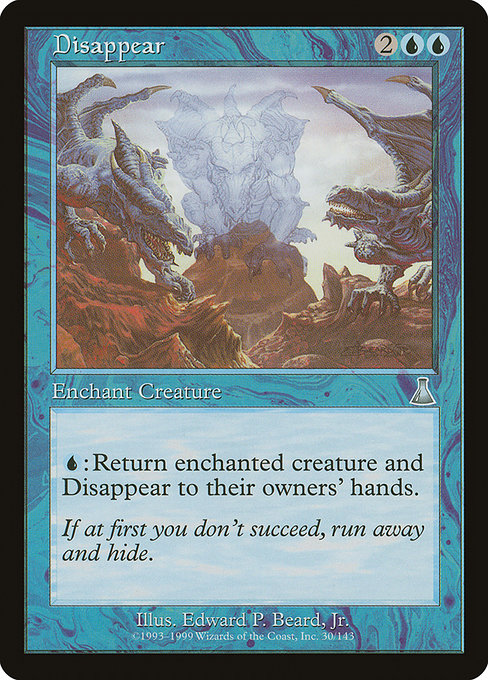
Image courtesy of Scryfall.com
Rarity, Mana Cost, and the Subtle Mathematics of Disappear
In Magic: The Gathering, rarity often invites a mental shortcut: more mana investment or game-wixing power should come with a higher price tag. Yet Disappear, an uncommon aura from Urza’s Destiny, reminds us that scarcity isn’t a straight line to strength. With a mana cost of {2}{U}{U} and an enchant creature clause, this card sits at 4 mana while delivering a precise tempo play: pay a single blue to bounce the enchanted creature and the aura back to their owners’ hands. The juxtaposition—modest rarity paired with a fairly specific, situational effect—is a hat-tip to the intricacies of set design, where rarity reflects distribution, not necessarily the card’s fun-to-play value. 🧙♂️🔥
Disappear’s rarity is uncommon in Urza’s Destiny (UDS). The set era—late 1990s—was rich with experimental enchantments and clever kidnappings of resources on the cheap, blue’s playground of tempo and control often leaning on subtle trickery rather than brute force. The card’s type line—Enchantment — Aura—and its specific keywords speak to a deliberate design choice: Enchant creature, and for a single blue mana, Return enchanted creature and this Aura to their owners’ hands. It’s a two-for-one tempo play that punishes overextension without begging for a heavy mana commitment. The flavor text—“If at first you don't succeed, run away and hide.”—lands with a wry wink, underscoring a strategy built on evasion, misdirection, and timing. ⚔️
“If at first you don't succeed, run away and hide.”
From a gameplay perspective, Disappear operates best in a blue tempo or control shell that survives on attrition and hand advantage. You cast the aura on an opponent’s creature to force a forced retreat—your opponent spends a spell to keep the critter in play, you respond with Disappear, and suddenly both the creature and the aura return to their owners’ hands. That buys you precious turns of field stability while you refill your hand with cantrips and bounce back threats. The cost of the spell punishes reactive play if you mismanage the timing, but when executed well, it’s a hallmark of blue’s “weave the tempo” philosophy. 🧙♂️🎲
Consider the practicalities: you’ll often use Disappear against low-cost creatures that are pivotal to an opponent’s board plan. If you enchant a fragile attacker, your single blue mana ping at instant speed lets you bounce the blocker rather than the attacker, effectively turning a block into a tempo swing. If you enchant a standout creature that’s about to swing for lethal damage, you can protect yourself by ensuring the threat returns to the hand while the aura comes home with you. The design hinges on timeliness—a hallmark of blue’s archetypal toolkit—and it rewards good tempo calculations more than raw raw power. 🧭
Rarity in this case doesn’t equate to “overpowered for its cost.” Instead, it aligns with the era’s taste for precise interactions that can tip a game when placed in the right moment and deckbuilding context. In modern terms, you’d compare it to other blue auras that trade immediate board presence for a swing in tempo or information. The uncommon slot ensures it’s accessible enough for players to experiment with but not so ubiquitous that it dilutes rare-design space. The card’s foil version—priced around a modest premium—offers that collector’s glow without forcing a steep price tag, echoing how Disappear’s value often lives in its flexibility more than its raw numbers. 💎
Flavor, art, and placement also matter here. Edward P. Beard, Jr.’s illustration from 1999 carries a retro vibe that complements the aura’s sneaky, blue-sky attitude. The set’s mechanical roster—an uncommon with a clever bounce trigger—helps illustrate a broader principle: rarity isn’t a direct proxy for usefulness, but for how a card fits into the ecosystem of a given set. In tournaments and casual play alike, you’ll see Disappear shine in moments that feel like a well-timed wink to your opponent. 🧙♂️
For collectors and players alike, Disappear is a reminder that design constraints—mana cost, rarity, and a card’s effect—are a balancing act. The card’s CMC 4 sits at a crossroads: enough mana to cast in a concentrated tempo moment, but not so cheap that it becomes a broken staple in every blue deck. In Legacy and Vintage circles, it can find unexpected homes in blink- or tempo-oriented builds, where the ability to bounce threats and reclaim the aura’s presence becomes part of a nuanced resource economy. It’s a snapshot of an era where blue’s trickery met uncommon scarcity and found its own little niche. 🧙♂️🔥
Practical takeaways for your MTG collection
- Rarity doesn’t guarantee power. Disappear is uncommon, yet its value lies in timing and matchup context rather than raw stats.
- Mana cost as design constraint. At 4 mana, it’s an investment you deploy when you’re ready to swing tempo in the near term.
- Blue’s tempo toolkit shines here. Enchant creature and bounce mechanics reward careful sequencing and anticipation of your opponent’s threats.
- Collector interest often follows foils and print runs; the foil version can carry a modest premium even if nonfoil remains approachable.
- Format legality matters. In today’s landscape, while not standard-legal, it’s Legacy and Vintage-friendly, with Commander and other eternal formats embracing the playful, club-like potential of bounce effects.
As you browse the broader MTG landscape, Disappear serves as a friendly reminder: rarity and mana cost are part of a larger conversation about how a card fits into a deck, a set, and a moment in time. For fans of blue’s cerebral, tempo-forward play, it’s a delightful little piece of history that still sparks imagination and clever plays. 🧙♂️💬
Clear Silicone Phone Case: Slim, Durable ProtectionMore from our network
- https://crypto-acolytes.xyz/blog/post/arcade-tournament-legends-iconic-moments-that-shaped-retro-gaming/
- https://blog.digital-vault.xyz/blog/post/interpreting-teff_gspphot-color-temperature-for-a-distant-blue-giant-star/
- https://crypto-acolytes.xyz/blog/post/predicting-markets-with-machine-learning-a-modern-guide/
- https://crypto-acolytes.xyz/blog/post/building-epic-underground-bases-in-minecraft/
- https://blog.digital-vault.xyz/blog/post/mastering-curve-placement-with-oggyar-battle-seer-aggro/